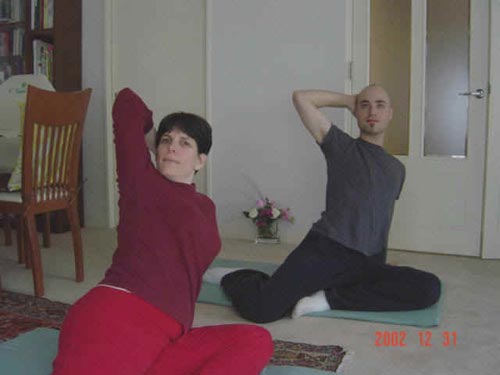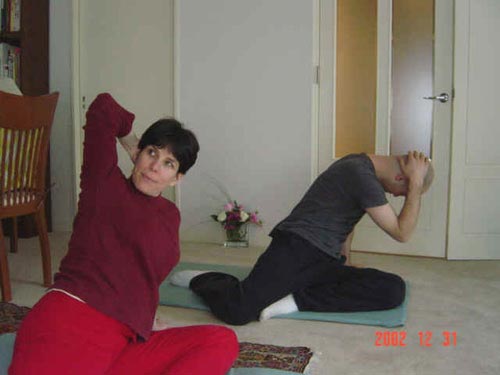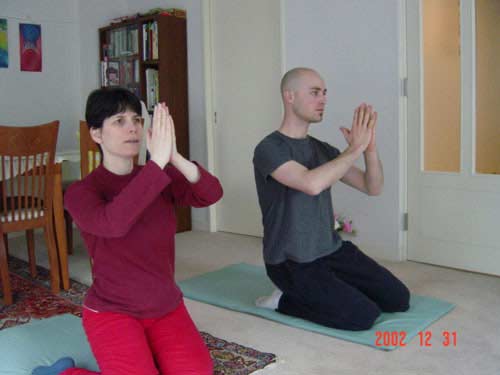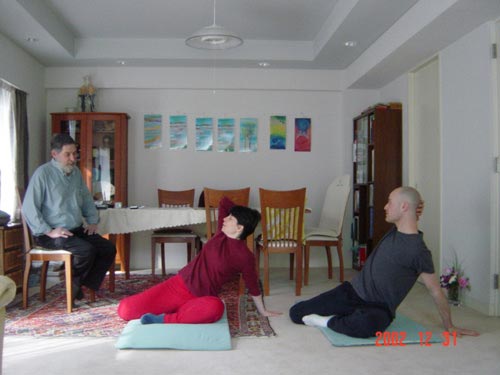The
group lesson
Awareness Through
Movement
By:
Rinat Levin-Chervin
This
very moment, while you are reading this article, pay one
moment of attention to the way you sit or lie down. Do
not change anything, do not attempt anything. Just pay
attention. You will surely discover some interesting
things, which may turn out to be useful.
Please note, do you feel comfortable? Do you breathe
freely, or are your breaths fast, shallow, sparse and
short? Are your shoulders dropped forward, or pulled
back? Where is your head? Is it bent down or held
upright? What about the legs? Are they crossed, or
spaced out wide? Are your legs bent, or stretched out
long? Do they swing at a certain pace? How are your back
and neck feeling? Are they tense, or free? And do you
need any support when sitting or lying down?
If
you are sitting, note the support to your body. Are you
sitting on the edge of the chair, or stretched wide on
an armchair? Do you lean on the back support, or on the
table in front, using your arms and elbows?
If
you are lying down, notice the way you lie. Do you lie
on your back, on your side or on your stomach? Do you
need a pillow for support under your head or legs?
Now,
try to imagine how you would change your posture,
breathing and feeling, in the following events: this
minute, your boss/ your spouse / the janitor / your
colleague / enters the room and starts talking to you.
This puts you in a situation in which you are happy,
angry, interested, bored.
After you answered all these questions to yourself, try
to figure out why you decided to choose this posture or
another, and is it connected to certain habits which you
have acquired during the course of your life? Is it
related to your character, temper, status? Is there
something you would like to change or improve?
In
person there are other people in the room with you, do
not tell them anything, and examine them quickly, from a
distance, like you did to yourself. Ask the same
questions again, regarding them.
Habits of Movement
I
can say with absolute certainty, that following such a
short, random observation as described above, the
conclusions and answers to the same questions will
differ for each person. If you keep doing this examine
on more and more people, you will realize that each
person has his own specific, typical posture and unique
way of moving, which he/she acquired during the course
of his/her life, and which is completely different from
any other person’s.
These habits of movement are usually adapted to the
physique, life experience, status, profession, character
and body image of every one of us.
Some
of our acquired habits of movement are “correct”,
“good”, and serve us properly. Others are harmful to our
health, limiting, frustrating and obstructing us,
causing various pains, inconvenience, and damages whose
origins we are not aware of.
Ways
of moving (walking, sitting, standing, turning, running,
swimming, riding bicycle, dancing, bending, lifting
objects, carrying baskets or bags, getting up) that are
“incorrect”, “wrong”, “lacking” or too “excessive”
cause, over the years, disorders, degeneration, and
physical and mental illnesses.
Body and Soul
Such
disorders affect the body and soul and eventually cause
a decline in the general functioning capability.
This
decline in general functioning is expressed and usually
accompanied with: pains, aches, fatigue, stress,
inconvenience.
In
extreme persons, this decline in functioning can lead to
total malfunction: physical disability, paralysis,
dependency on others and inability to function
independently.
Returning to normal
functioning
In
the Feldenkrais lessons we regain our capabilities, and
by doing this, return to normal functioning.
During the lessons, every student undergoes a process of
self re-examining and re-discovering, which enables him
to reach his potential in a minimum amount of effort,
and maximum efficiency, all through developing the
awareness to his body.
Each
student undergoes an internal learning process of “know
thyself!” (words usually attributed to Socrates). The
student performs a sequence of movements according to
verbal instructions given by the teacher. The movements
are gentle, complex, effortless and unforced. They are
neither mechanic nor aggressive, and are not performed
in a dictated pace, nor through imitating the teacher.
The
student moves slowly while thinking and listening to his
own movement, body and breathing. The dosage is
individual, with each student moving according to his
own pace, understanding and ability. The performance of
the movements is not a competition, neither between the
student and other students, nor is the student competing
against himself. The student is in no way required to
please the teacher, whether through ideas, movements, or
ideal posture. This is a (basic) (fundamental) principle
guiding the Feldenkrais method, and uniquely
distinguishing it.
The course of the
lessons
During the lessons, the student gets to know his body,
its way of moving and its range of capabilities. Through
this observation and movement, he discovers tissues,
tendons, joints, muscles and vertebrae, which so far
went unnoticed, or unused. This way, the student’s
awareness and sensitiveness to his body and its
movement, develop and grow.
The
movements are guided by the teacher in a gradual,
continuous manner, in order to improve a specific
function every lesson. For example: improving the
ability to bend forward while sitting or standing.
Rolling from a lying (supine) position, into sitting.
Rising in various ways from sitting to a standing
position. The lesson’s movemental
topics are most varied, each lesson differs from
the previous one, and lessons do not repeat themselves.
Every lesson, a new, additional challenge is being set
to the student, thereby keeping the student interested,
and curious. In each lesson, we examine certain topics
from different viewpoints.
Persistence
People who persist in performing a wide range of lessons
and movements, while listening to their inner voices and
sensations and noticing the nuances, the connections,
the relations and the small changes taking place all at
the same time, are able to widen the range of their
possible movements, retain their flexibility, increase
their movement potential, and choose for themselves the
movement path that is best suited and most correct for
them.
Every lesson is an exciting internal experience, at the
end of which the student feels that he had rediscovered
his potential, and that his present way of moving is
more diverse, efficient, flexible, light, clear and
aesthetic.
In
addition, the student had learned new information about
his body, and understood connections and mutual
relations between the different actions and functions in
his own “human machine”, with which he is now even more
acquainted and friendly.
The lessons purpose
The
lessons purpose is to improve and enhance one’s
capability and widen the limits of his performance, in
order to enable him to perform seemingly difficult,
perhaps even impossible, actions, and make them easy,
flexible, comfortable, pleasant and enjoyable.
High
flexibility, especially in older age, is most essential
in maintaining the body’s normal functioning. It
contributes to an efficient and regular functioning of
the internal organs, and prevents health disorders, pain
and disease.
In
this method we put an emphasis on the way to perform a
movement, and on its quality, rather than on the (mere)
content of the exercises. This is another fundamental
principle that guides the Feldenkrais method.
Introspection
In
the Feldenkrais method, we look inside ourselves as if
observing a drawing or a photograph. We activate our
nervous system, think and feel while in action, and by
doing so we “watch” the existing movement habits. This
observation brings about our desired change.
This
is another fundamental principle, underlying the method,
and distinguishing it: we do not shift from one rigid,
existing state to another, ideal, desirable state.
Rather, it is observing the existing state, which
initiate internal processes that lead to change. The
change is spontaneously expressed, in preserving and
maintaining what is useful (“correct“ habits), in
changing changeable incorrect habits, and in the ability
to tell them apart.
After the student accumulated some “impressions”,
learned and understood, to a certain extent, a number of
principles regarding his body and the way it moves, he
is able to analyze the source of his problems, and
possesses a tool in attempting to solve them.
Awareness
We
are aware that most people wish to dispose of bad habits
quickly, or “by miracle”. However the truth is, that
most people are not prepared to break the fixed pattern
they became accustomed to. Mostly, they look for a
shelter, and want to live in a secure, familiar
territory - whether it is in life in general, within the
family, in the bank, in the professional life – free
from any revolutions or obstructions (how many people do
you know, who continue and persist in a diet they went
on, or in giving up smoking?). From this we learn how
difficult it is to change existing habits, of any sort.
The
student’s look at himself and at the way he moves, the
confidence he acquires from better knowing himself, and
the fact that he knows a few more ways to move – bring
him to acknowledge the need for change, by himself. It
is then that his internal processes begin to change, and
the improvements soon follow.
The observed
improvements
The
observed improvements: the student gets out of his
previously “stuck” situation, and begins to move in a
new, easier, more interesting manner. He becomes more
flexible, his posture changes and improves, his mood
improves, he feels more stable physically and mentally,
his breathing becomes more smooth. His coordination and
his sense of direction and orientation, improve. He
becomes more likeable, friendlier, more relaxed and
open. His backaches disappear, he feels light, fresh and
calm, more at ease, on friendlier terms with himself. He
is able to realize and utilize his huge potential, which
existed all that time but was not properly utilized so
far. He is able to better handle daily pressure and
stressful situations.
Group lessons –
awareness through movement
The
group lessons that are unique to the Feldenkrais method
are usually carried out while lying on the back or
stomach. This way we neutralize the force of gravity,
exerted on our extensors and flexors (muscles which we
use to bend or extend ourselves ). Accordingly, the
muscular tonus is lowered, and so is the influence of
the background noise, both internal and external. Low
muscle tone and slow, effortless movements while
listening to one’s own breathing and movement, enhance
the ability to notice, the sensitiveness and the
awareness.
This
course of movement provides optimal conditions for
learning and re-education of the nervous system.
Hence, the learning process requires: patience,
persistence, openness, and both internal and external
listening.
During the process the student has to be prepared, at
times, to feel unconfident, fear and frustration, but
since our way of learning is the same as the natural
learning of a baby - trial and error - we should not be
angry with ourselves or criticize ourselves when
slipping down along our way.
The
method’s efficiency
The
Feldenkrais method is most useful in improving the
quality of life for people who suffer from functional
disorders in the following areas:
A. Physical
-
limited movement,
inability to bend, turn, move freely, difficulty in
lifting objects, getting dressed, tying up shoe laces,
going up and down stairs as a result of back problems
such as disc hernia, scoliosis, kiphosis,
lumbago and more.
Damage to internal organs as a result of incorrect
posture; Digestion and metabolic disorders, due to
incorrect breathing; High muscle tonus, Osteoporosis
(thinning of the bones due to loss of calcium, resulting
from insufficient exercise and
lack of bone growth stimulus).
B. Social/
personal
- absences from
work; inability to function at home; irritability, impatience; aggression towards family members; inability to dance and enjoy social
events.
Deficient functioning in
professions which require extensive walking and
supervision, as a
result of back
problems, pains and limited mobility.
C. Mental
- anxiety, lack of
confidence, sense of insecurity, lack of wish to live,
depression and
even suicidal
tendency - resulting from poor physiological condition,
flawed posture, breathing disorders and deficient,
abnormal functioning.
The method is
essential
The
method is essential for
people who want to get rid of pain in
their back, neck, shoulders and knees; to people who
want to ease stress and pressure resulting from
workload, studies, exams; to people who are paralyzed, disabled,
or suffer from brain and spinal cord damage, as a result
of neurological diseases, or accidents; to elderly
people; to artists – actors, dancers, musicians,
players, painters and more, who wish to improve their
awareness to their body and in this way to improve their
expressiveness; to anyone who wants to improve and
nurture his posture and his quality of life, anyone who
wants to enjoy a healthy life full of energy and
freshness deep into old age.
Published in: “Briut al burya” An alternative medicine
magazine
|
שיטת פלדנקרייז
מודעות דרך תנועה
מאת: רינת לוין-צ'רבין
ברגע זה ממש, בשעה שאתה קורא כתבה זו
שים לב לרגע לאופן
הישיבה שלך או השכיבה שלך
אל תשנה שום דבר, אל תשתדל.
רק
שים לב. מובטח לך שתגלה דברים מעניינים, שיוכלו להפוך
למועילים.
שים לב האם אתה
מרגיש בנוח? האם אתה נושם לרווחה? או נושם נשימות מהירות,
רדודות, דלילות וקצרות? האם כתפייך שמוטות לפנים או משוכות
לאחור? היכן נמצא ראשך? כפוף או זקוף? והרגליים? מסוקלות, בפיסוק
רחב או צר? האם הן כפופות, ארוכות או מתוחות? האם הן מתנדנדות
בקצב מסוים? איך מרגישים הגב והצוואר שלך? מאומצים או חופשיים?
והאם אתה זקוק לתמיכה כלשהי בזמן הישיבה או השכיבה?
אם אתה יושב - שים לב למשען
גופך! האם אתה יושב על קצה הכסא או שרוע עמוק אל תוך הכורסא? האם
אתה נשען על המשענת מאחור, או בעזרת המרפקים והאמות על השולחן
מלפנים?
אם אתה שוכב – שים לב לאופן
השכיבה שלך! האם אתה שוכב על הגב, צד, או על הבטן? האם אתה זקוק
לכרית כתמיכה מתחת לראש, או מתחת לרגלייך?
נסה עכשיו לדמיין
במחשבתך כיצד תשנה את תנוחת גופך, נשימתך, הרגשתך במקרים הבאים:
ברגע זה נכנס/ת לחדר הבוס שלך, אשתך/בעלך, המנקה, עמיתך לעבודה
ומתחיל/ה לדבר איתך. זה מכניס אותך למצב שבו אתה שמח, כועס,
מתעניין, משועמם.
לאחר שענית לעצמך
על כל השאלות הללו, נסה לשער לעצמך מדוע החלטת לבחור דווקא
בתנוחה זו או אחרת, והאם יש לזה קשר להרגלים מסוימים שאימצת
לעצמך במהלך חייך? האם יש קשר לאופייך, למזג רוחך, למעמדך? האם
יש משהו שהיית רוצה לשנות או לשפר?
אם נמצאים עמך
אנשים נוספים בחדר אל תגיד להם דבר, וסרוק אותם במהירות, מרחוק,
כמו שעשית על עצמך, שאל שוב אותן השאלות לגביהם.
הרגלי תנועה
אני יכולה להגיד
בביטחון גמור, שבעקבות התבוננות קצרה ואקראית כזאת שלעיל,
התשובות והמסקנות לאותן השאלות בשני המקרים היו שונות. אם תמשיכו
לעשות סקירה זו על עוד ועוד אנשים באוכלוסייה, תגיע לכלל הבנה –
שלכל אדם צורת תנוחה והתנועעות מסוימת האופיינית לו, שסיגל
לעצמו במהלך חייו,
השונה לחלוטין משל זולתו.
הרגלי תנועה אלו,
מותאמים לרוב למבנה, ולחוויות החיים, למעמד, למקצוע, לאופי,
ולדימוי הגוף של כל אחד מאתנו.
חלק מהרגלי התנועה
שאנו מסגלים לעצמנו "נכונים", "טובים", ומשרתים אותנו כיאות.
חלקם מזיקים לבריאותנו, מגבילים, מתסכלים, ומסרבלים אותנו,
גורמים לנו לכאבים שונים, לאי- נוחות, ולנזקים שאיננו מודעים
למקורם.
אופני תנועה
(הליכה, ישיבה, עמידה, פניה, ריצה, שחיה, רכיבה על אופניים,
ריקוד, התכופפות, הרמת חפצים, סחיבת סלים או תיקים, קימה) "לא
נכונים" או "שגויים", "לוקים בחסר" או "מועשרים בעודף" גורמים עם
השנים לשיבושים, להתנוונות, ולמחלות בגופו ובנפשו של האדם.
גוף ונפש
שיבושים שונים אלו
משפיעים על הגוף והנפש ובסופו של דבר גורמים לירידה ביכולת
התפקוד הכללי של האדם.
ירידה בתפקוד הכללי
מתבטאת ומלווה לרוב ב: כאבים, מיחושים, עייפות, מתח, אי-נוחות.
ירידה זו בתפקוד,
במקרים קיצוניים מביאה את האדם עד לאי-תפקוד מלא, כמו: נכות,
שיתוק, פיתוח תלות בחברה, אי יכולת לתפקד לבד.
חזרה לתפקוד תקין
בשעורי פלדנקרייז
אנו מחזירים לעצמנו את הכושר שלנו, וע"י כך חוזרים לתפקוד תקין.
בשעורים כל תלמיד
עובר תהליך למידה עצמי מחדש, המאפשר לו לממש את יכולתו במינימום
מאמץ ומקסימום יעילות, וכל זאת דרך פיתוח המודעות לגופו.
כל תלמיד עובר
תהליך למידה פנימי של "דע את עצמך" (מילים המיוחסות, בדרך כלל,
לסוקרטס).
התלמיד במצע רצף של
תנועות עפ"י הוראות מילוליות של המורה. התנועות הן עדינות,
מורכבות, ללא כוח או מאמץ, אינן מכניות או תוקפניות ואינן נעשות
בקצב מוכתב או תוך חיקוי תנועת המורה.
התלמיד מתנועע
באופן איטי תוך כדי מחשבה וקשב לתנועתו, לנשימתו ולגופו, עפ"י
מינון אישי. כל תלמיד מתנועע לפי הקצב, ההבנה, והיכולת שלו.
ביצוע התנועות אינו תחרותי, לא בין התלמיד לזולתו ולא בין התלמיד
לעצמו. התלמיד אינו נדרש בשום אופן לרצות את המורה, ברעיון או
באופן תנועה, או מנח אידיאלי – עיקרון יסודי המנחה את שיטת
פלדנקרייז ומייחד אותה.
מהלך השעורים
במהלך השעורים
התלמיד לומד להכיר את גופו, ואת אופן תנועתו וטווחי היכולת שלו,
ותוך התבוננות והתנועעות זאת הוא מגלה רקמות, גידים, מפרקים,
שרירים וחוליות שמעולם לא שם לב אליהם או שלא השתמש בהם. על-ידי
כך מודעותו ורגישותו לגופו ולתנועתו מתפתחות ועולות.
התנועות מונחות
על-ידי המורה באופן מודרג והמשכי, במטרה לשפר תפקוד ספציפי בכל
שיעור, כמו למשל: שיפור כפיפה לפנים בישיבה, בעמידה, התגלגלות
משכיבה על הגב לישיבה, קימה מישיבה לעמידה בצורות שונות. נושאי
השיעורים התנועתיים מגוונים ביותר, כל שיעור שונה מקודמו,
השיעורים אינם חוזרים על עצמם. בכל שיעור מוצב לתלמיד אתגר חדש
נוסף, ועל-ידי כך נשמרים סקרנותו ועניינו של התלמיד. בכל שיעור
אנו בוחנים נושאים מסוימים מזוויות ראייה שונות.
התמדה
אנשים המתמידים
בביצוע מגוון רחב של שיעורים ותנועות תוך הקשבה פנימית, לתחושה
ומתוך האבחנה בדקויות, בקשרים, ביחסים, ובשינויים הקטנים
המתחוללים באותה העת, מרחיבים את קשת אפשרויות התנועה שלהם,
שומרים על גמישותם, מגדילים את הפוטנציאל התנועתי שלהם, ובוחרים
לעצמם את דרך התנועה המתאימה והנכונה ביותר בשבילם.
כל שיעור הינו
חוויה פנימית מרתקת, שבסופו התלמיד יוצא עם התחושה שגילה מחדש את
היכולת הגלומה בו ושעכשיו תנועתו מגוונת, יעילה, גמישה, קלה,
ברורה ואסתטית יותר.
בנוסף לכך למד
התלמיד אינפורמציה חדשה על גופו, הבין קשרים ויחסים הדדיים בין
הפעולות השונות והתפקודים ב"מכונה האנושית" שלו, וכעת הוא אף
מיודד עמה יותר.
מטרת השיעורים
מטרת השיעורים היא
לשפר ולשכלל את יכולתו של האדם, להרחיב
את גבולות הביצוע שלו,
על-מנת שיוכל לבצע פעולות שלכאורה נראות קשות ואולי גם בלתי
אפשריות, ולהפכן לקלות, גמישות, נוחות נעימות ומהנות.
יכולת גמישות
גבוהה, בייחוד בגיל מאוחר, חיונית ביותר בשמירה על תפקוד תקין של
הגוף, הדבר תורם לפעילות יעילה ותקינה של האיברים הפנימיים,
ומונע הפרעות בריאות, כאבים ומחלות.
בשיטה זו אנו שמים
דגש על דרך הביצוע ואיכות התנועה ולא על תוכן התרגילים. זהו
עיקרון יסודי נוסף המנחה את שיטת פלדנקרייז.
התבוננות פנימה
בשיטת פלדנקרייז
אנו מתבוננים פנימה בעצמנו כמו ברישום או בצילום, מפעילים את
מערכת העצבים, חושבים וחשים תוך כדי עשייה, ועל-ידי כך "צופים"
בהרגלי התנועה הקיימים. הסתכלות זו מביאה את השינוי הרצוי לנו.
זהו עיקרון בסיסי
נוסף המנחה את השיטה ומייחד אותה בכך שאין אנו עוברים ממצב קשיח
מצוי אחד למצב אידיאלי רצוי שני, אלא ההסתכלות על הקיים היא
הגורמת להתחלת תהליכים פנימיים, היוצרים שינוי. השינוי מתבטא
באופן ספונטני בשימור ובתחזוק המועיל (ההרגלים התנועתיים
ה"נכונים"), ובשינוי ההרגלים הניתנים לשינוי, וביכולת ההבחנה
בהבדל שביניהם.
לאחר שהתלמיד צבר
"רישומים" אחדים, למד והבין במידה מסוימת מספר חוקים על גופו
ואופן תנועתו, יש באפשרותו לנתח את מקור בעיותיו, ובידו כלי
לנסות לפותרן.
מודעות
אנו מודעים לכך
שרוב האוכלוסייה מעונינת להיפטר במהרה או בדרך נס מהרגלים
"רעים", אך האמת היא שרוב האנשים אינם מוכנים כלל לשבור את
התבנית הקבועה שלה התרגלו. על-פי רוב הם מחפשים מחסה, רוצים
לחיות בשטח בטוח ומוכר, כמו בחיים, במשפחה, בבנק, או במקצוע,
משוחררים מכל מהפכות והפרעות (כמה אנשים אתה מכיר שממשיכים
ומתמידים בדיאטה או בגמילה מעישון?), ומכאן אנו למדים עד כמה קשה
לשנות הרגלים מכל סוג שהוא.
הסתכלות התלמיד
בעצמו ובאופן התנועעותו, הרגשת הביטחון שרכש לאחר היכרות הדוקה
יותר עם עצמו, והעובדה שיש לו מספר דרכים נוספות להתנועע –
מביאים אותו לעמוד על הצורך בשינוי בעצמו. אז גם מתחילים שינויים
בתהליכים הפנימיים שלו, ובאים לידי ביטוי השיפורים.
השיפורים הנצפים
השיפורים הנצפים:
התלמיד יוצא מהמצב ה"תקוע" הקודם בו היה, ומתחיל להתנועע באופן
חדש, קל ומעניין יותר, הוא נעשה גמיש יותר. יציבתו משתנה
ומשתפרת, מצב-רוחו עולה, הוא מרגיש יציב יותר גופנית ונפשית,
נשימתו נעשית חופשית יותר. הקואורדינציה וההתמצאות שלו במרחב
משתכללות, הוא נעשה נחמד וחברותי יותר, משוחרר ופתוח יותר. כאבי
הגב שלו נעלמים, הוא חש קליל רענן ונינוח, שלם יותר עם עצמו.
מסוגל לממש וליישם את הפוטנציאל העצום שמצא בתוכו, שקיים בו כל
הזמן אך עד כה לא נוצל כראוי. הוא מצליח להתמודד טוב יותר במצבי
לחץ ומתח בחיי היום יום.
שיעורים קבוצתיים –
מודעות דרך תנועה
השיעורים הקבוצתיים
המייחדים את השיטה (קיימת גם צורת הלימוד האישית) , מתבצעים לרוב בשכיבה על הגב או הבטן. על-ידי כך אנו
מנטרלים את כוח המשיכה הפועל על שרירנו הזוקפים והכופפים בהתאמה,
המתח השרירי פוחת, וכך יורדת השפעתו של רעש הרקע החיצוני
והפנימי. מתח שרירים נמוך ותנועות איטיות חסרות מאמץ תוך כדי
הקשבה לנשימה ולתנועה מגבירים את כושר ההבחנה, הרגישות והמודעות.
מהלך תנועה שכזה
מאפשר תנאים אופטימליים ללימוד וחינוך מחדש של מערכת העצבים.
אם כן תהליך הלמידה
העצמי דורש: סבלנות, התמדה, פתיחות, הקשבה פנימית וחיצונית גם
יחד.
בזמן התהליך התלמיד
צריך להיות מוכן, לעיתים, להרגשת חוסר ביטחון, פחד, תיסכול, אך
מכיוון שדרך הלמידה שלנו היא כדרך למידתו הטבעית של תינוק,
ניסיון וטעייה, אל לנו לכעוס על עצמנו או לבקר את עצמנו בעת
מעידתנו בדרך.
יעילות השיטה
שיטת פלדנקרייז
מועילה בעיקר לשיפור איכות החיים בקרב אוכלוסייה הסובלת מהפרעות
תפקודיות במישורים הבאים:
א.
הגופני –
הגבלות בתנועה, חוסר יכולת להתכופף, לפנות, לנוע בחופשיות, קושי
בהרמת חפצים, בהתלבשות, בשריכת שרוכי נעליים, בעליה וירידה
במדרגות כתוצאה מבעיות גב כגון: פריצת דיסקוס, עצב לחץ,
סקוליוזיס (עקמת), קיפוזיס, לומברגו ועוד; פגיעה באיברים פנימיים
כתוצאה מיציבה לא נכונה; בעיות עיכול ומטבוליזם, בגלל נשימה לא
נכונה; מתח שרירים גבוה; בריחת סידן מהעצמות, בגלל חוסר
התנועעות מספקת וחוסר גירוי של גדילת העצם.
ב.
החברתי
אישי – העדרויות
מהעבודה; חוסר יכולת תפקוד בבית;
חוסר סבלנות; תוקפנות כלפי בני המשפחה; חוסר יכולת להנות ולרקוד
באירועים חברתיים;
תפקוד לקוי
במקצועות הדורשים הליכה מרובה, סיור ופיקוח, בגלל בעיות גב,
כאבים ומוגבלות בתנועה.
ג.
הנפשי –
חרדות, חוסר ביטחון, הרגשת אי-ודאות, חוסר רצון לחיות, דיכאון
ועד רצון להתאבדות – בעקבות מצב פיזיולוגי ירוד, יציבה לקויה, אי
סדירות בנשימה, תפקוד לא תקין.
השיטה חיונית
השיטה חיונית
לאנשים הרוצים להיפטר מכאבי גב, צוואר, כתפיים, ברכיים; לאנשים
המעונינים להפיג מתחים ולחצים הנובעים מעומס עבודה, לימודים,
בחינות; למשותקים, נכים, לנפגעי מוח ועמוד שדרה, כתוצאה ממחלות
נוירולוגיות או תאונות דרכים; לקשישים; לאומנים – שחקנים,
רקדנים, מוסיקאים, נגנים, ציירים ועוד, המעונינים לשפר את
המודעות לגופם ועל-ידי כך לשכלל את אופן הביטוי שלהם; לכל מי
שרוצה
לשפר ולטפח את יציבתו ואת איכות חייו, לכל מי שרוצה להנות
מחיים בריאים ומלאי מרץ רעננות ואנרגיה בגיל מבוגר
פורסם בעיתון-בריאות
על ברויה
|
Nestor Levin
and Rinat Levin Chervin
M.Sc.
Certified, expert teachers
of the Feldenkrais method,
are happy to
respond to any inquiry on the matter
At tel:
054-5907755
Telefax:
972-3-9364272
To the other articles -
go up
and
click on the
other subject
Note:
The information offered in this
website is in no way
substitute
to medical counseling and/or treatment
|
|
|




